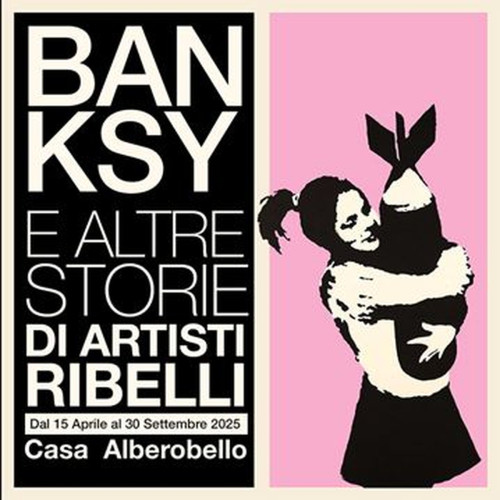from tuesday 15 April till martedì 30 settembre 2025
exhibit
Banksy e altre storie di artisti ribelli | Locus Festival 2025
 Art & photography
Art & photography

In the landscape of contemporary art, rebellion has taken on various forms: from political protest to market subversion, from the occupation of urban spaces to the rejection of exhibition conventions. At the center of this galaxy of creative insurgents, **Banksy emerges as a paradigmatic figure of art that has transformed disobedience into an aesthetic language and anonymity into a manifesto.** Banksy's choice to hide behind a pseudonym is not merely a publicity stunt but an ideological position that overturns the narcissism typical of the contemporary art system. While his face remains unknown, his works suddenly appear on the walls of Belfast, London, New York, or Gaza, turning the urban fabric into a democratic and accessible gallery. His stencils – from "Flying copper" to "Bomb Love" – condense complex critiques into immediate images that speak to both the intellectual and the distracted passerby. His antagonism extends to the art market itself, with sensational gestures like the self-destruction of a work just auctioned or the unauthorized installation of his works in the rooms of the most prestigious museums. These actions expose the paradoxes of a system that turns even the most radical protest into a luxury commodity, forcing us to question the very possibility of authentically subversive art in the era of its economic reproducibility.
The long wave of street art has generated a community of artists who, albeit with different approaches, share the vocation of removing art from traditional circuits. **OBEY** (Shepard Fairey) turned his "André the Giant Has a Posse" campaign into a visual empire ranging from political posters to commercial design, maintaining, however, a thematic consistency centered on the critique of power. His "HOPE" image for Obama's campaign perhaps represents the moment when street art definitively crossed the boundary between counterculture and mainstream. **TVBOY** translates this attitude in the Mediterranean context, with interventions that turn Italian and European political news into instantly recognizable pop icons. His depictions of political leaders kissing or in provocative poses generate public debate, demonstrating how unauthorized artistic action can still spark collective discussions. **Mr. Brainwash**, whose story is inextricably linked to Banksy through the documentary "Exit Through the Gift Shop," represents a case study on the commodification of rebellion. His rapid rise in the art market raises questions about how easily the aesthetics of protest can be absorbed by the system it pretended to criticize; while **Rizek** explores new expressive frontiers through material research that transcends the boundaries between painting and object.
Critique takes on more subtle and sophisticated forms in the work of artists operating within the institutional system. **Damien Hirst** has made provocation his distinctive hallmark, from the famous series of animals in formaldehyde to the pill cabinets, works that challenge cultural taboos as well as market limits. His decision to bypass galleries by selling an entire show directly at auction represents a different form of revolt against the conventions of the art world. **Takashi Murakami** subverts hierarchies between high and low culture, between East and West, blending Japanese pictorial tradition with manga and anime aesthetics. His "superflat" is not just a style but a critical theory that reads contemporary society as a flattening of values, where art is confused with merchandise and vice versa. His collaboration with luxury brands like Louis Vuitton doesn't represent a capitulation to commerce but a subversive infiltration into the circuits of global consumption.
**Liu Bolin**, the Chinese artist known as the "invisible man," has developed a unique form of protest: painting his body to completely blend in with the background, he physically disappears into his works. Started as a reaction to the Chinese government's demolition of his studio, this practice has evolved into a global critique of the mechanisms of individual erasure in contemporary society, and his visual disappearance paradoxically represents the highest form of presence. **KAWS** (Brian Donnelly), too, began his career with acts of visual rebellion, illegally intervening on advertising posters to replace models' faces with his iconic character with crossed-out eyes. His trajectory, from illegal graffiti to monumental sculptures, from collaborations with Dior to millionaire valuations, narrates how rebellion can evolve without necessarily betraying itself.
This generation of dissident artists fits into a tradition that has in **Andy Warhol** one of its forefathers. His Factory, his silkscreens, and his elevation of banal objects into art icons represented in the 1960s a radical challenge to aesthetic conventions. His famous statement "In the future, everyone will be famous for fifteen minutes" eerily foreshadowed the era of social media and instant celebrity in which contemporary artists operate. In Italy, **Mario Schifano** embodied a form of dissent that was more existential and less programmatic. His feverish life, his experimental approach to media, and his ability to absorb and reinterpret both high and popular culture made him a reference figure for generations of artists. His works – from "monochromes" to "screens" – represent a critical appropriation of television and advertising language that anticipates many strategies of contemporary artists.
Finally, **Nello Petrucci** and **Angelo Accardi** represent more recent evolutions of this rebellious attitude in the Italian context. The former, with his layered collages that blend pop imagery and references to art history, creates visual short-circuits that invite a critical reading of the contemporary image overdose. The latter, with his surreal compositions populated by ostriches and incongruous characters, subverts narrative expectations, creating scenarios that challenge the linear logic of visual storytelling.
**The exhibition Banksy and Other Stories of Rebel Artists** teaches us that artistic protest is a delicate balance between compromise and radicality, and the main challenge is to maintain the integrity of their critique while navigating a system that tends to absorb and neutralize every form of dissent by turning it into a commercial product. Independence in contemporary art is not perhaps measured in the ability to remain completely outside the system – a probably impossible goal – but in maintaining a liminal, boundary position, where the artistic operation retains its ability to disturb, question, and subvert even while inevitably participating in the mechanisms it intends to criticize. In an era when authenticity itself has become a market value, these artists remind us that the deepest rebellion lies not in sensational gestures but in the consistency with which one pursues a vision, in the courage to constantly question even one's own positions, and in the ability to transform protest into a visual language that can effectively reach and influence as wide an audience as possible.
The exhibition, exclusive to the **Locus Festival 2025**, is curated by **Piernicola Maria Di Iorio**, produced and organized by **Bass Culture** and **Piuma**, with the sponsorship of the **Municipality of Alberobello**.
**Opening Hours**
*Tuesday to Friday 10:00 - 13:00 | 16:00 - 20:00
Saturday, Sunday, holidays, May 2nd 10:00 - 20:00
Monday closed
The ticket office and entrance close one hour earlier*
|
from tuesday 15 April till martedì 30 settembre 2025
City: Alberobello (Bari)
Venue: Casa Alberobello, largo Martellotta
at 10:00
paying entrance
Info. www.bassculture.it
|
| |
|
|
11147 views


 Art & photography
Art & photography
 www.bassculture.it
www.bassculture.it
